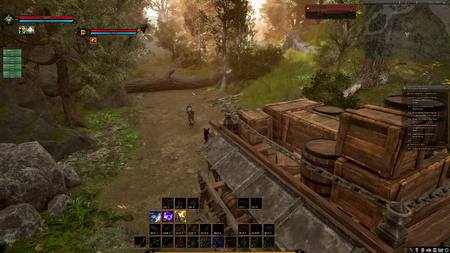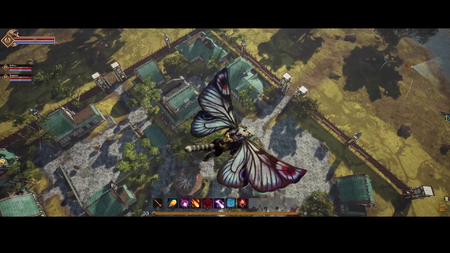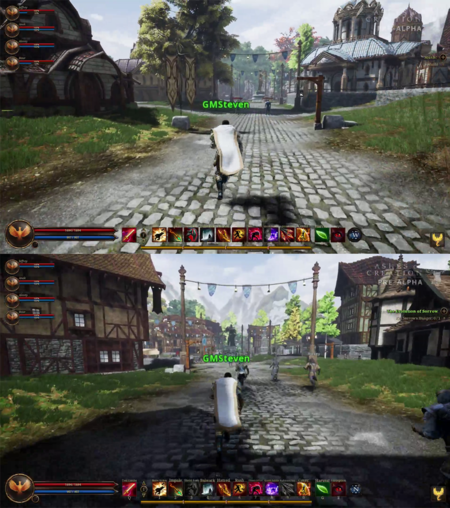Procedural generation
Ashes of Creation will predominantly have curated content, but procedural mechanics will be leveraged in a places where they don't appear to be 'procedural'.[1]
- Verra's map will not be procedurally generated, but starting resource points may be different on each server.[2][3]
- Node locations and types are predefined and are the same on each server but they will develop differently on each and drive different narratives and storylines.[4][3][5]
- Node layout and style is determined by several factors, such as Environment (biome) and location, Node type, and Race.[6][7]
- Roads are both pre-generated and player influenced.[1][8]
Wherever we can leverage procedural mechanics in such a way that does not appear procedural we should. There's a healthy blend between the things that we do in having defined parameters for it and then incorporating a procedural component; and in that sense it will be perceived well, but where we the predominance of what we're implementing should be curated or by design.[1] – Steven Sharif
Roads

Our road system in-game is essentially driven by pre-placed routes that lead to this main artery of what was once the ancient highway system of Verra; and from there there are roads that become exposed when nodes advance; and we call those veins. They come off the main artery and then as nodes advance there are points of interest as Jeff was discussing earlier. These POIs that exist around the world and some of them share coverage with multiple nodes, but depending on which node advances to the stage that activates the point of interest it'll create these capillary roads so to speak that then stem off of the node itself. So you go from the main artery ancient road that's large- that runs through different zones and whatnot- and that breaks down into the veins that lead to the specific encampments and villages and towns that then spawn off separate capillaries that lead to the points of interest in these areas that are hunting grounds. Those are not exposed initially and they come online as players advance the world.[8] – Steven Sharif
As nodes advance, these pre-laid road spots that exist connecting every possible route between certain node structures is going to adjust and adapt, both its material presentation, the type of roadwork that's present: It'll move from dirt road type, to perhaps a brick road, to perhaps some super ornate beautiful metropolis style road that will adjust around the world according to how these node structures begin to populate and advance.[10] – Steven Sharif
Roads in Verra are both pre-generated and player influenced.[8]
- The largest roads are referred to as arteries. These are remnants of what was once the ancient highway system of Verra.[8]
- As nodes advance smaller roads, referred to as veins, connect the arteries to the nodes.[8]
- Depending on the stages of node advancement, capillary roads will stem off the node to connect to points of interest.[8]
- Roads or pathways are not worn into the landscape by repeated traffic over the same area.[8]
- The quality, safety, and maximum transportation speed of roads is influenced by node building upgrades, policies, relics, and the level of nearby nodes.[11][12][13]
- Q: Could you upgrade roads in the node to upgrade the roads and speeds of caravans?
- A: Absolutely. So that buff that you saw is a buff that can be changed in the world based on the world state. Some of those world state interactions include certain types of relics that the nodes which govern your area might have access to and might be actively employing. Some of it might have to do with policies: You might be able to extend the guard influences across the road radius further out for certain nodes if you have certain policies. You might be able to enhance and empower those guards through itemization choices that are granted by building upgrades that the node selects to build.[11] – Steven Sharif
Different seasons and events may affect access to various roads.[14][15][16][17]
- Pathways that are open during summer may be closed during winter.[14][17]
- Seasonal affects may cause obstacles or blockages to the transit of goods via caravan.[14][15][16][18]
- Caravan events can cause roadways to be blocked off or hostile mobs to spawn to attack the caravan.[9][15]
- Water turning to ice in winter, enabling players to walk over the water but blocking access to what is underneath.[17]
- Ice will make roads bumpy and slippery.[19]
Underrealm routes will open or close dynamically (based on node states).[20]
- The location of Underrealm entrances throughout the world is focused around natural geographic choke-points that exist above ground. This provides alternate subterranean routes that can be used by caravans, raids, and other player activities.[21][20]
- Not all entrances to the Underrealm will be open at the same time. This can shift dynamically (based on node states) that cause different routes to open up, which may be more or less advantageous than other routes.[20]
Caravan components can be utilized to improve on-road or off-road speeds of caravans.[22]
- You will travel faster over roads, but that obviously comes with the increased risk of running into other players or monsters that are blocking the road.[22] – Chris Justo
Propriedades may not be placed in close proximity to roads.[23]
Node layout and style

Já no terceiro estágio de evolução, como uma vila, é um layout razoavelmente grande; e parte desses layouts inclui domicílos essencialmente estáticos, dentro da base, que os jogadores podem comprar.[24] – Steven Sharif

O layout e a arquitetura dentro da área de desenvolvimento de uma Base são determinados pela raça com mais influência. Por exemplo, uma Base em estágio 3 onde a maioria dos jogadores contribuíntes é Py'Rai terá uma vila Py'Rai com arquitetura Py'Rai. A maioria dos PNJs seriam elfos Py'Rai, e ofereceriam missões com narrativa Py'Rai.[4] – Margaret Krohn
A experiência contribuída por cada jogador é marcada com sua raça e outros identificadores. Quando uma Base evolui, a raça com a maior contribuição de experiência determina o estilo e cultura da Base. Essa mudança de estilo e cultura pode ocorrer em todo Estágio de Base. Por exemplo, se uma Base avança para o Estágio 2 - Acampamento e 51% de toda a experiência veio de jogadores Ren'Kai, a Base será uma Base Ren'Kai Estágio 2. Se essa mesma Base avançar para o Estágio 3 - Vilarejo, mas dessa vez os Py'rai tiverem contribuído 62% de tpda a experiência obtida, a Base se tornará uma Base Py'Rai Estágio 3. Influências culturais trazem mudanças além da estética e das missões - benefícios são dados àqueles da cultura dominante dentro da Zona de Influência daquela Base.[26] – Margaret Krohn
O layout e o estilo de uma Base são determinados por diversos fatores:[7]
- Localização da base.[7]
- Tipo de Base.[7]
- Raça que mais contribuiu para a evolução da Base.[7][27]
- Aparências raciais dos prédios e dos PNJs de uma Base.[28][27]
- Isso se aplica a todas as bases, incluindo bases de castelo.[29]
- O resto é determinado pelo prefeito da base.[7]
Algumas partes são determinadas pela área onde a base está. Outras, pelo tipo da base; certas partes são determinadas pela raça, e o resto é determinado pelo prefeito.[7] – Jeffrey Bard
Todas as bases, sejam elas relacionadas aos castelos ou não, têm influências culturais que são replicadas nas aparências dos prédios e dos PNJs presentes na Base.[29] – Steven Sharif
Existe uma mecânica de atrito que afeta a experiência e influência para impedir que uma única raça domine o mundo inteiro.[30]
Existe um atrito e esse atrito na experiência e influência aumenta de acordo com a performance da raça no mundo. Então se todas as bases forem de Orc, o nível de atrito deles será muito alto para competir com outras raças na hora de estabelecer a cultura de novas bases. Isso acontece pois já são muito influentes e existe uma opinião popular contra eles nas regiões que não influenciam.[30] – Steven Sharif
Gerenciador mundial
O Gerenciador Mundial é um algorítmo em Ashes of Creation responsável por controlar elementos dinâmicos do mundo. Ele age como um sistema tanto limitador como incentivador para diversas atividades, com o objetivo de garantir que certos parâmetros estejam dentro de limites aceitáveis.[31]
- Preços de certificados de caça.[32]
- Um mapa de atividade da experiência recebida para ser usada na evolução de base.[32]
- Movimentação de recursos e bens entre regiões para incentivar recompensas de missões nas bases.[32]
Por exemplo, se você sabe que o ferro está sendo usado como um recurso primário na fabricação de certos itens, isso pode aumentar o preço da prata ou do mithril; isso pode incentivar o mercado a se corrigir um pouco. A ideia é oferecer pequenos incentivos para ajudar a aliviar a demanda e também aumentar a oferta que pode não estar presente nos sistemas econômicos.[32] – Steven Sharif
Ver também
Referências
- ↑ 1.0 1.1 1.2 Transmissão ao vivo, 2022-02-25 (1:07:36).
- ↑

- ↑ 3.0 3.1 Transmissão ao vivo, 2017-05-19 (37:03).
- ↑ 4.0 4.1 Blog - Know Your Nodes - The Basics.
- ↑ A reactive world - Nodes.
- ↑ Transmissão ao vivo, 2020-10-30 (39:17).
- ↑ 7.0 7.1 7.2 7.3 7.4 7.5 7.6 Transmissão ao vivo, 2018-09-27 (53:06).
- ↑ 8.0 8.1 8.2 8.3 8.4 8.5 8.6 Transmissão ao vivo, 2021-01-29 (1:13:04).
- ↑ 9.0 9.1 9.2 Vídeo, 2023-10-31 (34:12).
- ↑ 10.0 10.1 Transmissão ao vivo, 2022-01-28 (33:25).
- ↑ 11.0 11.1 Transmissão ao vivo, 2023-10-31 (1:16:34).
- ↑ Vídeo, 2023-10-31 (28:06).
- ↑ Transmissão ao vivo, 2018-02-09 (45:48).
- ↑ 14.0 14.1 14.2 14.3 Vídeo, 2022-05-27 (15:50).
- ↑ 15.0 15.1 15.2 Podcast, 2021-04-11 (23:36).
- ↑ 16.0 16.1 Transmissão ao vivo, 2020-06-26 (1:29:06).
- ↑ 17.0 17.1 17.2 17.3 Transmissão ao vivo, 2017-05-08 (20:27).
- ↑ Our immersive world - Environments.
- ↑

- ↑ 20.0 20.1 20.2 Transmissão ao vivo, 2020-10-30 (1:19:13).
- ↑ Transmissão ao vivo, 2022-08-26 (53:26).
- ↑ 22.0 22.1 Vídeo, 2023-10-31 (20:17).
- ↑ Transmissão ao vivo, 2017-05-19 (32:23).
- ↑ 24.0 24.1 Transmissão ao vivo, 2020-06-26 (45:32).
- ↑ Transmissão ao vivo, 2018-02-09 (33:50).
- ↑ Blog - Know Your Nodes - Advance and Destroy.
- ↑ 27.0 27.1 Entrevista, 2018-05-11 (54:34).
- ↑ Transmissão ao vivo, 2017-05-26 (21:23).
- ↑ 29.0 29.1 Entrevista, 2018-05-11 (47:27).
- ↑ 30.0 30.1 Entrevista, 2018-05-11 (1:00:19).
- ↑ Entrevista, 2020-07-19 (1:10:55).
- ↑ 32.0 32.1 32.2 32.3 Entrevista, 2020-07-19 (1:08:22).